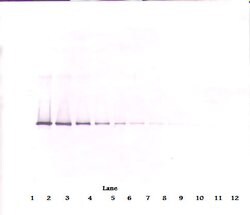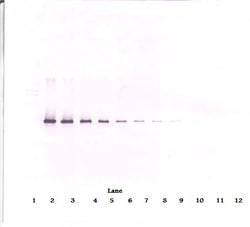Learn More
Invitrogen™ Neuroserpin Polyclonal Antibody, PeproTech®, Invitrogen™
Rabbit Polyclonal Antibody
Supplier: Invitrogen™ 500P271100UG

Description
AA Sequence of recombinant protein: MTGATFPEEA IADLSVNMYN RLRATGEDEN ILFSPLSIAL AMGMMELGAQ GSTQKEIRHS MGYDSLKNGE EFSFLKEFSN MVTAKESQYV MKIANSLFVQ NGFHVNEEFL QMMKKYFNAA VNHVDFSQNV AVANYINKWV ENNTNNLVKD LVSPRDFDAA TYLALINAVY FKGNWKSQFR PENTRTFSFT KDDESEVQIP MMYQQGEFYY GEFSDGSNEA GGIYQVLEIP YEGDEISMML VLSRQEVPLA TLEPLVKAQL VEEWANSVKK QKVEVYLPRF TVEQEIDLKD VLKALGITEI FIKDANLTGL SDNKEIFLSK AIHKSFLEVN EEGSEAAAVS GMIAISRMAV LYPQVIVDHP FFFLIRNRRT GTILFMGRVM HPETMNTSGH DFEEL. Preparation: Produced from sera of rabbits immunized with highly pure Recombinant Human Neuroserpin. Anti-Human Neuroserpin-specific antibody was purified by affinity chromatography employing an immobilized Human Neuroserpin matrix. Sandwich ELISA: To detect hHuman Neuroserpin by sandwich ELISA (using 100 μL/well antibody solution) a concentration of 0.5-2.0 μg/mL of this antibody is required. This antigen affinity purified antibody, in conjunction with PeproTech Biotinylated Anti-Human Neuroserpin (500-P271Bt) as a detection antibody, allows the detection of at least 0.2-0.4 ng/well of Recombinant Human Neuroserpin. Western Blot: To detect Human Neuroserpin by Western Blot analysis this antibody can be used at a concentration of 0.1-0.2 μg/mL. Used in conjunction with compatible secondary reagents the detection limit for Recombinant Human Neuroserpin is 1.5-3.0 ng/lane, under either reducing or non-reducing conditions.
This gene encodes a member of the serpin superfamily of serine proteinase inhibitors. The protein is primarily secreted by axons in the brain, and preferentially reacts with and inhibits tissue-type plasminogen activator. It is thought to play a role in the regulation of axonal growth and the development of synaptic plasticity. Mutations in this gene result in familial encephalopathy with neuroserpin inclusion bodies (FENIB), which is a dominantly inherited form of familial encephalopathy and epilepsy characterized by the accumulation of mutant neuroserpin polymers. Multiple alternatively spliced variants, encoding the same protein, have been identified.
Specifications
| Neuroserpin | |
| Polyclonal | |
| Unconjugated | |
| Serpini1 | |
| AI837402; DKFZp781N13156; neuroserpin; Ns; Peptidase inhibitor 12; PI12; PI-12; protease inhibitor 17; raPIT5a; serine (or cysteine) peptidase inhibitor, clade I, member 1; serine (or cysteine) proteinase inhibitor clade member 1; serine (or cysteine) proteinase inhibitor, clade I (neuroserpin), member 1; serine protease inhibitor 17; serpin family I member 1; serpin I1; serpin peptidase inhibitor clade I member 1; serpin peptidase inhibitor, clade I (neuroserpin), member 1; serpin peptidase inhibitor, clade I, member 1; SERPINI1; Spi17 | |
| Rabbit | |
| Antigen Affinity Chromatography | |
| RUO | |
| 5274 | |
| -20°C | |
| Lyophilized |
| ELISA, Western Blot | |
| 0.1-1.0 mg/mL | |
| PBS with no preservative | |
| Q99574 | |
| Serpini1 | |
| E.coli-derived Recombinant Human Neuroserpin. | |
| 100 μg | |
| Primary | |
| Human | |
| Antibody |
The Fisher Scientific Encompass Program offers items which are not part of our distribution portfolio. These products typically do not have pictures or detailed descriptions. However, we are committed to improving your shopping experience. Please use the form below to provide feedback related to the content on this product.


